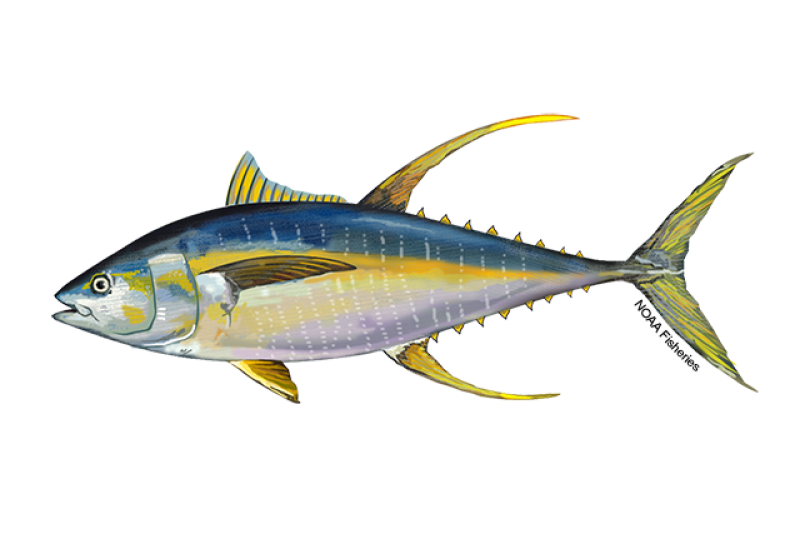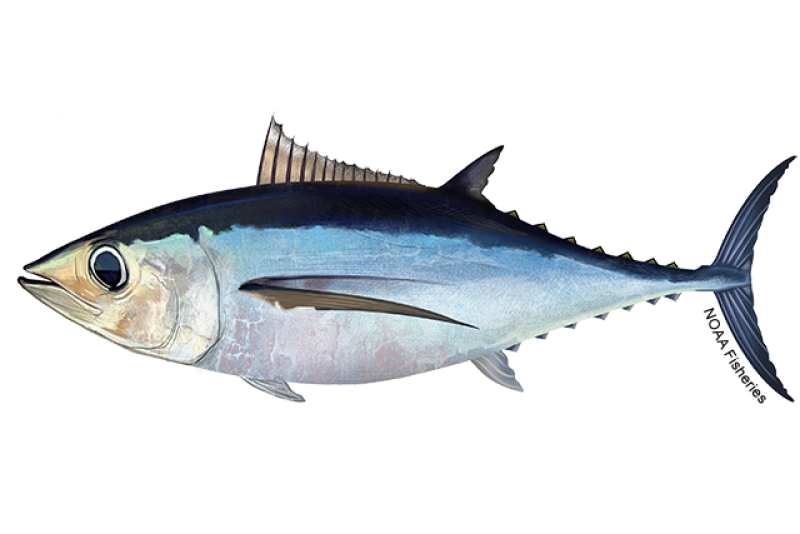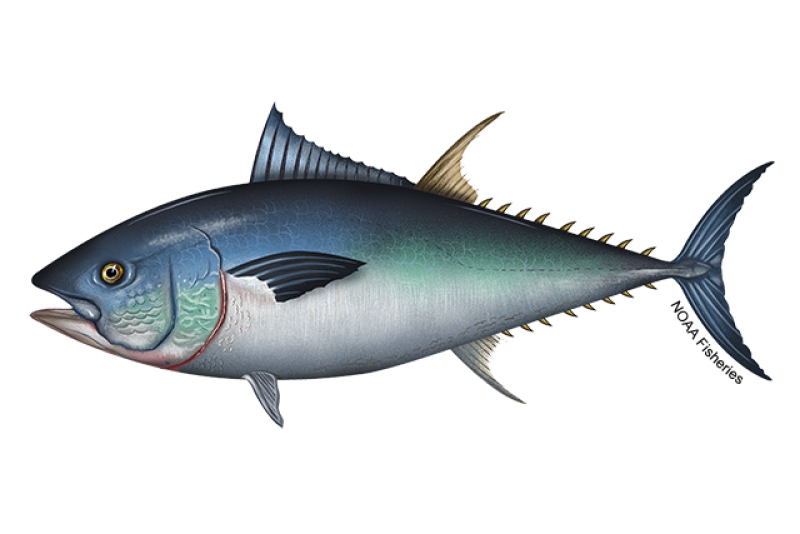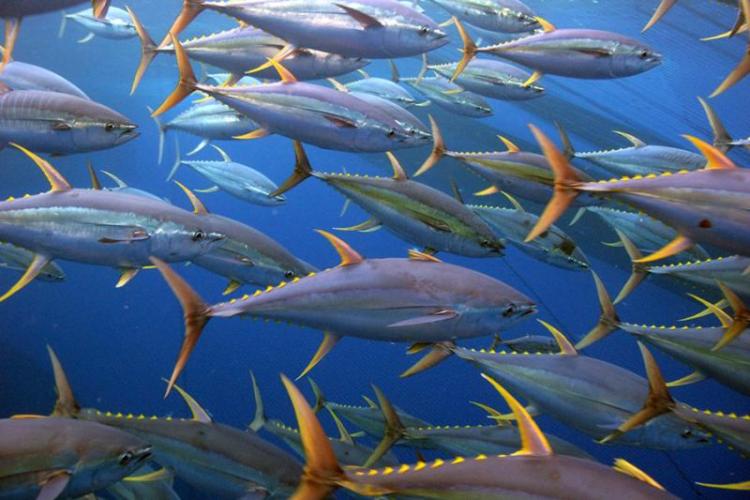 School of yellowfin tuna. Credit: Jeff Muir
School of yellowfin tuna. Credit: Jeff Muir
School of yellowfin tuna. Credit: Jeff Muir
About the Species
 School of yellowfin tuna. Credit: Jeff Muir
School of yellowfin tuna. Credit: Jeff Muir
School of yellowfin tuna. Credit: Jeff Muir
U.S. wild-caught Atlantic yellowfin tuna is a smart seafood choice because it is sustainably managed and responsibly harvested under U.S. regulations.

Population
The stock is not overfished.

Fishing Rate
Not subject to overfishing.

Habitat Impact
Fishing gears used to harvest yellowfin tuna have almost no impact on habitat because they’re used in the water column and don’t come into contact with the ocean floor.

Bycatch
Regulations are in place to minimize bycatch.
Population Status
- According to the 2024 stock assessment, Atlantic yellowfin tuna is not overfished and not subject to overfishing. Summary stock assessment information can be found on Stock SMART.
- The International Commission for the Conservation of Atlantic Tunas (ICCAT) assesses the abundance of Atlantic yellowfin tuna and evaluates the sustainability of current and proposed harvest practices. They use the scientific information from these assessments to make management recommendations.
Appearance
- Yellowfin tuna are torpedo-shaped.
- They are metallic dark blue on the back and upper sides, and change from yellow to silver on the belly.
- True to their name, their dorsal and anal fins and finlets are bright yellow.
- Yellowfin tuna can be distinguished from other tunas by their long, bright yellow dorsal fin and a yellow strip down the side. They are also more slender than bluefin tuna.
Biology
- Yellowfin tuna grow fairly fast, up to 400 pounds, and have a somewhat short life span of about 7 years.
- Most yellowfin tuna are able to reproduce when they reach age 2 or 3.
- In the western Atlantic, they spawn from May to August in the Gulf of America (formerly Gulf of Mexico) and from July to November in the southeastern Caribbean. In the eastern Atlantic, they spawn from October to March in the Gulf of Guinea and from April to June off Senegal.
- Females spawn about once every 3 days during the spawning season. They produce an average of 1 million to 4 million eggs each time they spawn.
- Yellowfin tuna feed near the top of the food chain on fish, squid, and crustaceans.
- They are prey for top predators such as sharks and large fish.
Where They Live
Range
- Yellowfin tuna are found near the surface of tropical and subtropical oceans around the world.
Habitat
Fishery Management
- NOAA Fisheries and the Atlantic Highly Migratory Species Division manage the Atlantic yellowfin tuna fishery in the United States.
- Managed under the 2006 Consolidated Atlantic Highly Migratory Species Fishery Management Plan and amendments:
- Commercial fishermen must have a permit to harvest yellowfin tuna.
- Gear restrictions.
- Time/area closures.
- Minimum size limit.
- Federal management for Atlantic tunas applies to state waters as well, except in Maine, Connecticut, and Mississippi. NOAA Fisheries periodically reviews these states’ regulations to make sure they’re consistent with federal regulations.
- Highly migratory species, such as yellowfin tuna, have complicated management that requires international cooperation.
- The United States participates in regional fisheries management organizations, such as the International Commission for the Conservation of Atlantic Tunas (ICCAT), to enhance tuna management worldwide. NOAA Fisheries sets regulations for the U.S. western Atlantic yellowfin tuna fishery based on our science as well as conservation and management measures adopted by ICCAT.
- In 2011, ICCAT adopted new yellowfin tuna management standards that reduced the catch of small yellowfin off West Africa and brought other fishing nations closer to U.S. standards.
- In 2013, ICCAT adopted a measure to expand reporting requirements for tropical tuna fisheries using fish aggregating devices (FADs). The measure will improve data collection and allow ICCAT scientists to better characterize the fishing effort associated with FAD fishing.
- In 2000, the United States established the Dolphin-Safe Tuna Tracking and Verification Program to monitor the domestic production and importation of all frozen and processed tuna products nationwide and to authenticate any associated dolphin-safe claim.
Harvest
- Commercial fishery:
- U.S. landings of Atlantic yellowfin tuna generally represent a small percentage of the total international landings of Atlantic yellowfin tuna.
- Yellowfin tuna is the principal species of tropical tuna landed by U.S. fisheries in the western North Atlantic.
- The majority of U.S. commercial landings come from the longline fleet operating in the northwest Atlantic, Gulf of America, and Caribbean.
- Gear types, habitat impacts, and bycatch:
- U.S. commercial fishermen primarily use longline, rod-and-reel, and handline gear to harvest Atlantic yellowfin tuna.
- Pelagic longline gear and handgear (handline and rod-and-reel) used to catch yellowfin tuna have no impact on habitat because they’re used in the water column and don’t come into contact with the ocean floor.
- Handgear is very selective so bycatch is minimal, but pelagic longlines can incidentally catch other fish and protected species such as marine mammals and sea turtles.
- NOAA Fisheries has taken the following additional measures to prevent bycatch and sustainably manage this fishery. Fishermen are:
- Required to use large circle hooks and certain types of bait that limit gear interactions with sea turtles. Circle hooks are specifically designed to minimize the damage caused by hooking, giving animals that are captured and released a better chance at survival.
- Trained to use special techniques to safely dehook and release any incidentally caught turtles.
- Required to stop fishing and move 1 nautical mile if they encounter a protected species.
- Required to protect pilot whales and Risso's dolphins when fishing in the Mid-Atlantic Bight by limiting the length of their lines to 20 nautical miles and posting marine mammal handling/release guidelines on their vessels. In addition, if fishing in the Cape Hatteras Special Research Area, pelagic longliners must contact NOAA Fisheries at least 48 hours prior to a trip and carry observers if requested.
- Required to use weak hooks in the Gulf of America to reduce incidental catch of bluefin tuna and prohibited from using live bait to reduce bycatch of billfish.
- Restricted from areas of the Gulf of America to reduce bycatch of all species.
- Required to carry vessel monitoring systems onboard their boats to ensure compliance with these closures.
- Required to carry at-sea fisheries observers upon request. NOAA Fisheries reviews observer data to monitor protected species interactions and takes appropriate action as necessary.
- Recreational fishery:
- A high proportion of landings are rod-and-reel catches by recreational anglers.
- Recreational fishermen enjoy catching yellowfin tuna because they’re large (up to 400 pounds) and they fight hard.
- Recreational fishermen must have a permit to catch yellowfin tuna.
- They have daily bag limits. However, catch, tag, and release is allowed.
- Recreational fishing for highly migratory species such as yellowfin tuna provides significant economic benefits to coastal communities through individual angler expenditures, recreational charters, tournaments, and the shoreside businesses that support those activities.
Scientific Classification
- Yellowfin tuna are found near the surface of tropical and subtropical oceans around the world.
Fishery Management
- NOAA Fisheries and the Atlantic Highly Migratory Species Division manage the Atlantic yellowfin tuna fishery in the United States.
- Managed under the 2006 Consolidated Atlantic Highly Migratory Species Fishery Management Plan and amendments:
- Commercial fishermen must have a permit to harvest yellowfin tuna.
- Gear restrictions.
- Time/area closures.
- Minimum size limit.
- Federal management for Atlantic tunas applies to state waters as well, except in Maine, Connecticut, and Mississippi. NOAA Fisheries periodically reviews these states’ regulations to make sure they’re consistent with federal regulations.
- Highly migratory species, such as yellowfin tuna, have complicated management that requires international cooperation.
- The United States participates in regional fisheries management organizations, such as the International Commission for the Conservation of Atlantic Tunas (ICCAT), to enhance tuna management worldwide. NOAA Fisheries sets regulations for the U.S. western Atlantic yellowfin tuna fishery based on our science as well as conservation and management measures adopted by ICCAT.
- In 2011, ICCAT adopted new yellowfin tuna management standards that reduced the catch of small yellowfin off West Africa and brought other fishing nations closer to U.S. standards.
- In 2013, ICCAT adopted a measure to expand reporting requirements for tropical tuna fisheries using fish aggregating devices (FADs). The measure will improve data collection and allow ICCAT scientists to better characterize the fishing effort associated with FAD fishing.
- In 2000, the United States established the Dolphin-Safe Tuna Tracking and Verification Program to monitor the domestic production and importation of all frozen and processed tuna products nationwide and to authenticate any associated dolphin-safe claim.
Harvest
- Commercial fishery:
- U.S. landings of Atlantic yellowfin tuna generally represent a small percentage of the total international landings of Atlantic yellowfin tuna.
- Yellowfin tuna is the principal species of tropical tuna landed by U.S. fisheries in the western North Atlantic.
- The majority of U.S. commercial landings come from the longline fleet operating in the northwest Atlantic, Gulf of America, and Caribbean.
- Gear types, habitat impacts, and bycatch:
- U.S. commercial fishermen primarily use longline, rod-and-reel, and handline gear to harvest Atlantic yellowfin tuna.
- Pelagic longline gear and handgear (handline and rod-and-reel) used to catch yellowfin tuna have no impact on habitat because they’re used in the water column and don’t come into contact with the ocean floor.
- Handgear is very selective so bycatch is minimal, but pelagic longlines can incidentally catch other fish and protected species such as marine mammals and sea turtles.
- NOAA Fisheries has taken the following additional measures to prevent bycatch and sustainably manage this fishery. Fishermen are:
- Required to use large circle hooks and certain types of bait that limit gear interactions with sea turtles. Circle hooks are specifically designed to minimize the damage caused by hooking, giving animals that are captured and released a better chance at survival.
- Trained to use special techniques to safely dehook and release any incidentally caught turtles.
- Required to stop fishing and move 1 nautical mile if they encounter a protected species.
- Required to protect pilot whales and Risso's dolphins when fishing in the Mid-Atlantic Bight by limiting the length of their lines to 20 nautical miles and posting marine mammal handling/release guidelines on their vessels. In addition, if fishing in the Cape Hatteras Special Research Area, pelagic longliners must contact NOAA Fisheries at least 48 hours prior to a trip and carry observers if requested.
- Required to use weak hooks in the Gulf of America to reduce incidental catch of bluefin tuna and prohibited from using live bait to reduce bycatch of billfish.
- Restricted from areas of the Gulf of America to reduce bycatch of all species.
- Required to carry vessel monitoring systems onboard their boats to ensure compliance with these closures.
- Required to carry at-sea fisheries observers upon request. NOAA Fisheries reviews observer data to monitor protected species interactions and takes appropriate action as necessary.
- Recreational fishery:
- A high proportion of landings are rod-and-reel catches by recreational anglers.
- Recreational fishermen enjoy catching yellowfin tuna because they’re large (up to 400 pounds) and they fight hard.
- Recreational fishermen must have a permit to catch yellowfin tuna.
- They have daily bag limits. However, catch, tag, and release is allowed.
- Recreational fishing for highly migratory species such as yellowfin tuna provides significant economic benefits to coastal communities through individual angler expenditures, recreational charters, tournaments, and the shoreside businesses that support those activities.
Scientific Classification
| Kingdom | Animalia | Phylum | Chordata | Class | Actinopterygii | Order | Scombriformes | Family | Scombridae | Genus | Thunnus | Species | albacares |
|---|
Last updated by NOAA Fisheries on 04/03/2025
Featured News
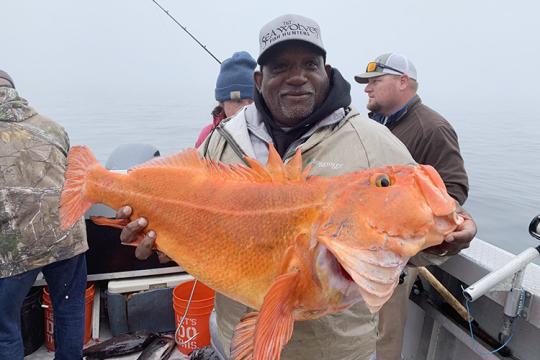
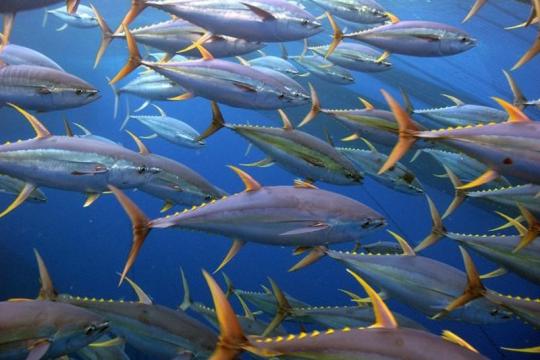 Tuna. Credit: NOAA Fisheries
Tuna. Credit: NOAA Fisheries
 School of yellowfin tuna. Credit: Jeff Muir
School of yellowfin tuna. Credit: Jeff Muir
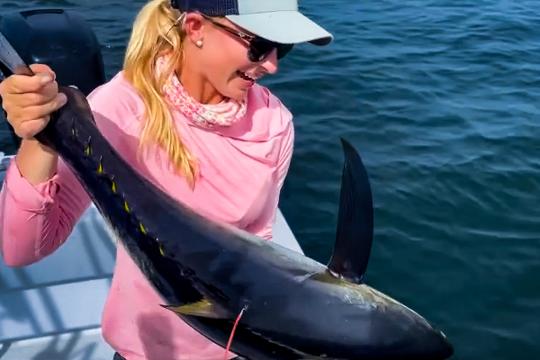 Lakelynn Devine prepares to release a yellowfin tuna with a conventional spaghetti tag (the red item sticking out near its dorsal fin) attached. Photo courtesy of Lakelynn and Blake Devine.
Lakelynn Devine prepares to release a yellowfin tuna with a conventional spaghetti tag (the red item sticking out near its dorsal fin) attached. Photo courtesy of Lakelynn and Blake Devine.
Seafood Facts

Is Atlantic Yellowfin Tuna Sustainable?
U.S. wild-caught Atlantic yellowfin tuna is a smart seafood choice because it is sustainably managed and responsibly harvested under U.S. regulations.
Availability
Year-round.
Source
U.S. wild-caught from Massachusetts to Texas.
Taste
Yellowfin tuna has a mild, meaty flavor. It’s more flavorful than albacore, but leaner than bluefin tuna.
Texture
The meat is firm and moist with large flakes.
Color
Meat is bright red when raw and turns brown to grayish-tan when cooked.
Health Benefits
Yellowfin tuna is low in saturated fat and sodium and is a very good source of protein, thiamin, selenium, vitamin B6, and omega-3s.
Nutrition Facts
Servings: 1; Serving Weight: 100 g (raw); Calories: 109; Protein: 24.4 g; Total Fat: 0.49 g; Total Saturated Fatty Acids: 0.172 g; Carbohydrate: 0 g; Total Sugars: 0 g; Total Dietary Fiber: 0 g; Cholesterol: 39 mg; Selenium: 36.5 mcg; Sodium: 45 mgMore Information
Yellowfin Tuna Recipes
There are many ways to cook tuna based on cut and species. For cooking inspiration, browse these recipes for baked tuna with fresh basil, herb broiled yellowfin, and more!

Last updated by NOAA Fisheries on 04/03/2025
Seafood News
 Thomas Piecuch flips floating oyster bags on his farm (Credit: Holy Ground Oyster Company).
Thomas Piecuch flips floating oyster bags on his farm (Credit: Holy Ground Oyster Company).
Celebrating Aquaculture Week: Farming from Tide to Table
 NOAA team members adjust a prototyped turtle excluder device (TED) before sending it to divers below for continued testing on the NOAA R/V Caretta. Credit: NOAA Fisheries (ESA Permit 20339)
NOAA team members adjust a prototyped turtle excluder device (TED) before sending it to divers below for continued testing on the NOAA R/V Caretta. Credit: NOAA Fisheries (ESA Permit 20339)
Small Modifications to Turtle Excluder Devices Have Big Impacts for Gulf Sea Turtles
 Pacific oysters travel down a sorting tumbler at Salty Lady Seafood Company in Juneau, Alaska. Credit: Salty Lady Seafood Company.
Pacific oysters travel down a sorting tumbler at Salty Lady Seafood Company in Juneau, Alaska. Credit: Salty Lady Seafood Company.
 Commercial fishing boats lined up in Sitka, Alaska. Credit: Shutterstock.
Commercial fishing boats lined up in Sitka, Alaska. Credit: Shutterstock.
NOAA Fisheries Seeks Recommendations for Restoring American Seafood Competitiveness
Research
Top Fish Taggers for the Cooperative Tagging Center
NOAA Fisheries greatly appreciates the many tagging teams and anglers who tag and release fish to support our science.
Groundfish Catch Percentage And Value
Alaska groundfish make up a sizable portion or Alaska's yearly catch. Their significance can be seen in the yearly numbers.
Outreach & Education
A Guide to Tunas of the Western Atlantic Ocean
Waterproof booklet to help commercial, for-hire, and recreational fishermen and fish dealers/buyers…
Caribbean Saltwater Recreational Fisheries Snapshot
Puerto Rico and the U.S. Virgin Islands saltwater recreational fisheries fact sheet highlighting…
Last updated by NOAA Fisheries on 04/03/2025
